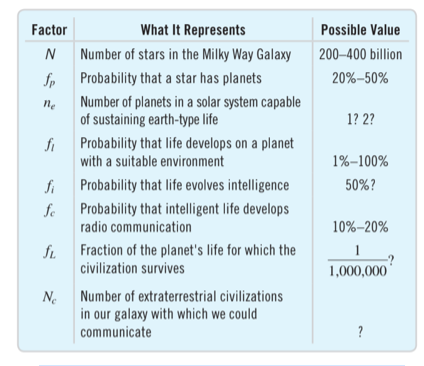Factor What It Represents Possible Value N Number of stars in the Milky Way Galaxy 200–400 billion fp Probability that a star has planets 20%-50% Number of planets in a solar system capable of sustaining earth-type life ne 1? 2? fi Probability that life develops on a planet with a suitable environment 1%-100% fi Probability that life evolves intelligence 50%? fe radio communication Probability that intelligent life develops 10%-20% fi Fraction of the planet's life for which the civilization survives 1 1,000,000 Number of extraterrestrial civilizations Ne in our galaxy with which we could communicate ?
Factor What It Represents Possible Value N Number of stars in the Milky Way Galaxy 200–400 billion fp Probability that a star has planets 20%-50% Number of planets in a solar system capable of sustaining earth-type life ne 1? 2? fi Probability that life develops on a planet with a suitable environment 1%-100% fi Probability that life evolves intelligence 50%? fe radio communication Probability that intelligent life develops 10%-20% fi Fraction of the planet's life for which the civilization survives 1 1,000,000 Number of extraterrestrial civilizations Ne in our galaxy with which we could communicate ?
Astronomy
1st Edition
ISBN:9781938168284
Author:Andrew Fraknoi; David Morrison; Sidney C. Wolff
Publisher:Andrew Fraknoi; David Morrison; Sidney C. Wolff
Chapter30: Life In The Universe
Section: Chapter Questions
Problem 31E: Think of our Milky Way Galaxy as a flat disk of diameter 100,000 light-years. Suppose we are one of...
Related questions
Question
The Drake equation In 1961 astronomer Frank Drake
developed an equation to try to estimate the number of
extraterrestrial civilizations in our galaxy that might be
able to communicate with us via radio transmissions. Now
largely accepted by the scientific community, the Drake
equation has helped spur efforts by radio astronomers to
search for extraterrestrial intelligence. Here is the equation:
largely accepted by the scientific community, the Drake
equation has helped spur efforts by radio astronomers to
search for extraterrestrial intelligence. Here is the equation:
NC = N # fp # ne # fl
# fi
# fc # fL
OK, it looks a little messy, but here’s what it means:So, how many ETs are out there? That depends; values
chosen for the many factors in the equation depend on
ever-evolving scientific knowledge and one’s personal
guesses. But now, some questions.
a) What quantity is calculated by the first product, N # fp?
b) What quantity is calculated by the product, N # fp # ne # fl
?
c) What probability is calculated by the product fl
# fi?
d) Which of the factors in the formula are conditional
probabilities? Restate each in a way that makes the
condition clear.
# fi
# fc # fL
OK, it looks a little messy, but here’s what it means:So, how many ETs are out there? That depends; values
chosen for the many factors in the equation depend on
ever-evolving scientific knowledge and one’s personal
guesses. But now, some questions.
a) What quantity is calculated by the first product, N # fp?
b) What quantity is calculated by the product, N # fp # ne # fl
?
c) What probability is calculated by the product fl
# fi?
d) Which of the factors in the formula are conditional
probabilities? Restate each in a way that makes the
condition clear.

Transcribed Image Text:Factor
What It Represents
Possible Value
N
Number of stars in the Milky Way Galaxy
200–400 billion
fp
Probability that a star has planets
20%-50%
Number of planets in a solar system capable
of sustaining earth-type life
ne
1? 2?
fi Probability that life develops on a planet
with a suitable environment
1%-100%
fi
Probability that life evolves intelligence
50%?
fe
radio communication
Probability that intelligent life develops
10%-20%
fi Fraction of the planet's life for which the
civilization survives
1
1,000,000
Number of extraterrestrial civilizations
Ne
in our galaxy with which we could
communicate
?
Expert Solution
This question has been solved!
Explore an expertly crafted, step-by-step solution for a thorough understanding of key concepts.
This is a popular solution!
Trending now
This is a popular solution!
Step by step
Solved in 3 steps with 2 images

Knowledge Booster
Learn more about
Need a deep-dive on the concept behind this application? Look no further. Learn more about this topic, physics and related others by exploring similar questions and additional content below.Recommended textbooks for you

Astronomy
Physics
ISBN:
9781938168284
Author:
Andrew Fraknoi; David Morrison; Sidney C. Wolff
Publisher:
OpenStax


Stars and Galaxies (MindTap Course List)
Physics
ISBN:
9781337399944
Author:
Michael A. Seeds
Publisher:
Cengage Learning

Astronomy
Physics
ISBN:
9781938168284
Author:
Andrew Fraknoi; David Morrison; Sidney C. Wolff
Publisher:
OpenStax


Stars and Galaxies (MindTap Course List)
Physics
ISBN:
9781337399944
Author:
Michael A. Seeds
Publisher:
Cengage Learning

Foundations of Astronomy (MindTap Course List)
Physics
ISBN:
9781337399920
Author:
Michael A. Seeds, Dana Backman
Publisher:
Cengage Learning

Horizons: Exploring the Universe (MindTap Course …
Physics
ISBN:
9781305960961
Author:
Michael A. Seeds, Dana Backman
Publisher:
Cengage Learning
